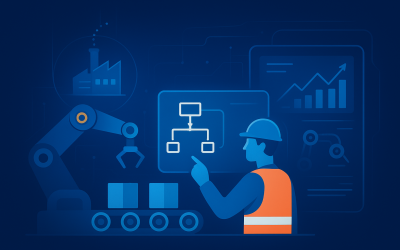The Role of Digital Twins in Enhancing Manufacturing Efficiency
What Are Digital Twins in Manufacturing?
Digital twins are virtual replicas of physical systems, processes, or products that are continuously updated with real-time data. In manufacturing, this means creating a live digital model of a production line, equipment, or entire factory. These models allow manufacturers to simulate, predict, and optimize performance without disrupting operations.
With sensors and IoT technology feeding data into digital twins, they become powerful tools for diagnostics, forecasting, and planning. As a result, organizations can make smarter, faster, and more cost-effective decisions across the entire production lifecycle.
How Digital Twins Improve Manufacturing Efficiency
1. Real-Time Monitoring and Predictive Maintenance
Digital twins manufacturing systems allow operators to monitor machinery health in real-time. Instead of waiting for something to break, predictive analytics warn teams before downtime occurs. This reduces unplanned outages and extends equipment life—saving both time and money.
2. Process Optimization and Simulation
Digital twins let engineers run simulations to evaluate changes without impacting production. Whether it’s testing a new machine layout or tweaking production parameters, these models enable safe experimentation and rapid iteration—helping manufacturers continually fine-tune efficiency.
3. Enhanced Supply Chain Coordination
By integrating digital twins with supply chain systems, companies gain a clearer picture of inventory, production schedules, and delivery timelines. This transparency reduces bottlenecks, improves forecasting accuracy, and supports just-in-time manufacturing models.
Digital Twins and Industry 4.0 Integration
The rise of Industry 4.0—the digital transformation of manufacturing—relies heavily on technologies like AI, IoT, and big data. Digital twins sit at the center of this revolution. They act as the connective tissue, aligning smart devices, analytics tools, and automated systems into a seamless, intelligent ecosystem.
Use Cases Across Manufacturing Sectors
From automotive and aerospace to food processing and pharmaceuticals, digital twins are transforming how manufacturers design, produce, and maintain their products. Examples include:
-
Automotive: Simulating vehicle assembly lines for leaner operations
-
Aerospace: Monitoring jet engine performance in real time
-
Pharma: Ensuring process compliance and quality control
The ROI of Digital Twin Implementation
While setting up a digital twin system involves upfront investment, the long-term ROI is significant. Companies see:
-
10–30% improvement in overall equipment effectiveness (OEE)
-
20–40% reduction in maintenance costs
-
Up to 50% faster time to market for new products
These benefits aren’t just theoretical—they’re being realized by manufacturers today who have embraced digital transformation.
Ready to Transform Your Operations?
Digital twins are no longer futuristic—they’re essential. If you’re looking to streamline production, minimize downtime, and stay ahead in a competitive market, TSVMap can help you bring your manufacturing digital twin to life.
![]() TSVMap is committed to enhancing your manufacturing processes and providing expert consultation on your IT solutions, striving to maximize their effectiveness and efficiency. If you require assistance with…IT Solutions, Assessment, Consultants, ERP Systems, MRP Systems, Automations, or Cyber Security. Contact us today at 864-991-5656 or Email info@tsvmap.com.
TSVMap is committed to enhancing your manufacturing processes and providing expert consultation on your IT solutions, striving to maximize their effectiveness and efficiency. If you require assistance with…IT Solutions, Assessment, Consultants, ERP Systems, MRP Systems, Automations, or Cyber Security. Contact us today at 864-991-5656 or Email info@tsvmap.com.









0 Comments